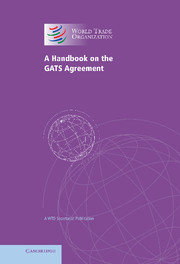Book contents
- Frontmatter
- Contents
- Preface
- Introduction
- 1 Basic purpose and concepts
- 2 Main building blocks: agreement, annexes and schedules
- 3 A closer look at domestic regulation
- 4 How the GATS is administered
- 5 The role and responsibilities of Member governments
- 6 The challenges ahead
- 7 Preparing requests and offers
- 8 Misconceptions about the GATS
- Appendix 1 Understanding your country's services trade
- Appendix 2 Relevant services statistics and classifications
- Annex: General Agreement on Trade in Services
- Index
7 - Preparing requests and offers
Published online by Cambridge University Press: 07 October 2011
- Frontmatter
- Contents
- Preface
- Introduction
- 1 Basic purpose and concepts
- 2 Main building blocks: agreement, annexes and schedules
- 3 A closer look at domestic regulation
- 4 How the GATS is administered
- 5 The role and responsibilities of Member governments
- 6 The challenges ahead
- 7 Preparing requests and offers
- 8 Misconceptions about the GATS
- Appendix 1 Understanding your country's services trade
- Appendix 2 Relevant services statistics and classifications
- Annex: General Agreement on Trade in Services
- Index
Summary
NEGOTIATING APPROACHES
In their Uruguay Round schedules many Members confined commitments to binding status quo conditions in a limited range of sectors. The number of services included, and the levels of access bound, in general remained modest. This may have been due to a variety of factors: the preference of governments to play it safe, that is to avoid tensions over the interpretation and application of a completely new set of rules; reticence on the part of services-related ministries and agencies which had no prior experience of international trade negotiations; the difficulties of small administrations, short of resources, to keep pace with the negotiating process in Geneva; and the instincts of seasoned negotiators, who, in the absence of requests from large trading partners, may have preferred to keep silent.
In order to benefit from GATS negotiations, however, it is necessary for governments to reconsider old habits. As noted above, unlike traditional trade agreements for goods, the GATS extends to consumer movements (mode 2) and the movement of production factors – in the form of investment flows intended to establish a commercial presence (mode 3) and of natural persons entering markets to supply a service (mode 4). Commitments under the relevant modes may enhance an economy's attractiveness for internationally mobile resources (human and/or physical capital) which, in turn, could help to overcome domestic supply shortages. It cannot be taken for granted that the requests received from trading partners, if any, coincide with an economy's developmental needs in attracting such resources.
- Type
- Chapter
- Information
- A Handbook on the GATS AgreementA WTO Secretariat Publication, pp. 43 - 47Publisher: Cambridge University PressPrint publication year: 2005

